Having extensive experience with wood stoves, I have learned about the challenging and hazardous substance called creosote. It is a sticky, tar-like buildup in our cherished stoves that presents a significant fire risk.
But fear not, my friends! In this article, I’ll guide you through the ins and outs of cleaning creosote from your wood stove, equipping you with the knowledge and tools you need to keep your stove safe and efficient.
Let’s banish that creosote and enjoy a worry-free winter!
Key Takeaways
- Creosote buildup in a wood stove can lead to chimney fires, so regular cleaning is essential.
- Using the right tools, such as a wire brush, shop vacuum, scraper, and dustpan, can make the cleaning process easier and more efficient.
- It is important to wear proper protective gear, including gloves, goggles, and a respirator, to minimize the risk of accidents and injuries.
- Choosing eco-friendly and non-toxic cleaning products, such as chimney cleaning logs, is recommended to ensure a clean and efficient wood stove while protecting the environment and health.
Understanding Creosote Buildup
I’ve noticed that creosote buildup can be a major issue when it comes to wood stoves. As someone with years of experience in using wood stoves, I understand the dangers that creosote can pose if not properly managed.
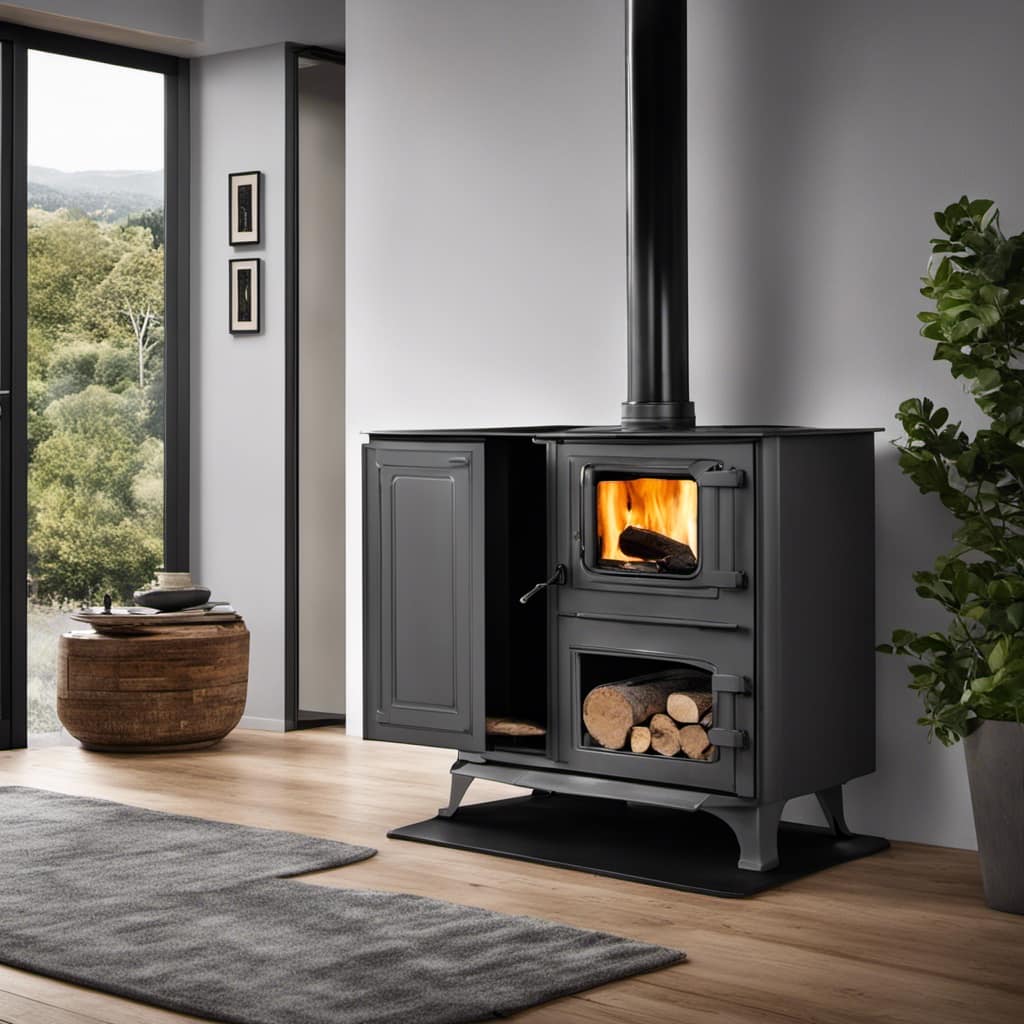
Creosote is a highly combustible substance that forms when wood is burned, and it can accumulate inside the chimney and stovepipe over time. This buildup can restrict airflow and lead to chimney fires, which can be extremely dangerous and cause significant damage to your home.
To prevent creosote buildup and ensure the safety of your wood stove, there are a few tips that I can share. Firstly, it’s important to burn only dry and seasoned wood. Wet or unseasoned wood produces more smoke, which increases the amount of creosote that forms.
Secondly, maintaining a hot fire can help minimize creosote buildup. A hot fire burns more efficiently and produces less smoke, reducing the amount of creosote that’s deposited. Additionally, regular chimney inspections and cleanings are essential. A professional chimney sweep can remove any existing creosote and ensure that your chimney is clear and safe.
Gathering the Necessary Tools and Supplies
Before beginning the task of cleaning creosote from a wood stove, it’s crucial to gather all the necessary tools and supplies.
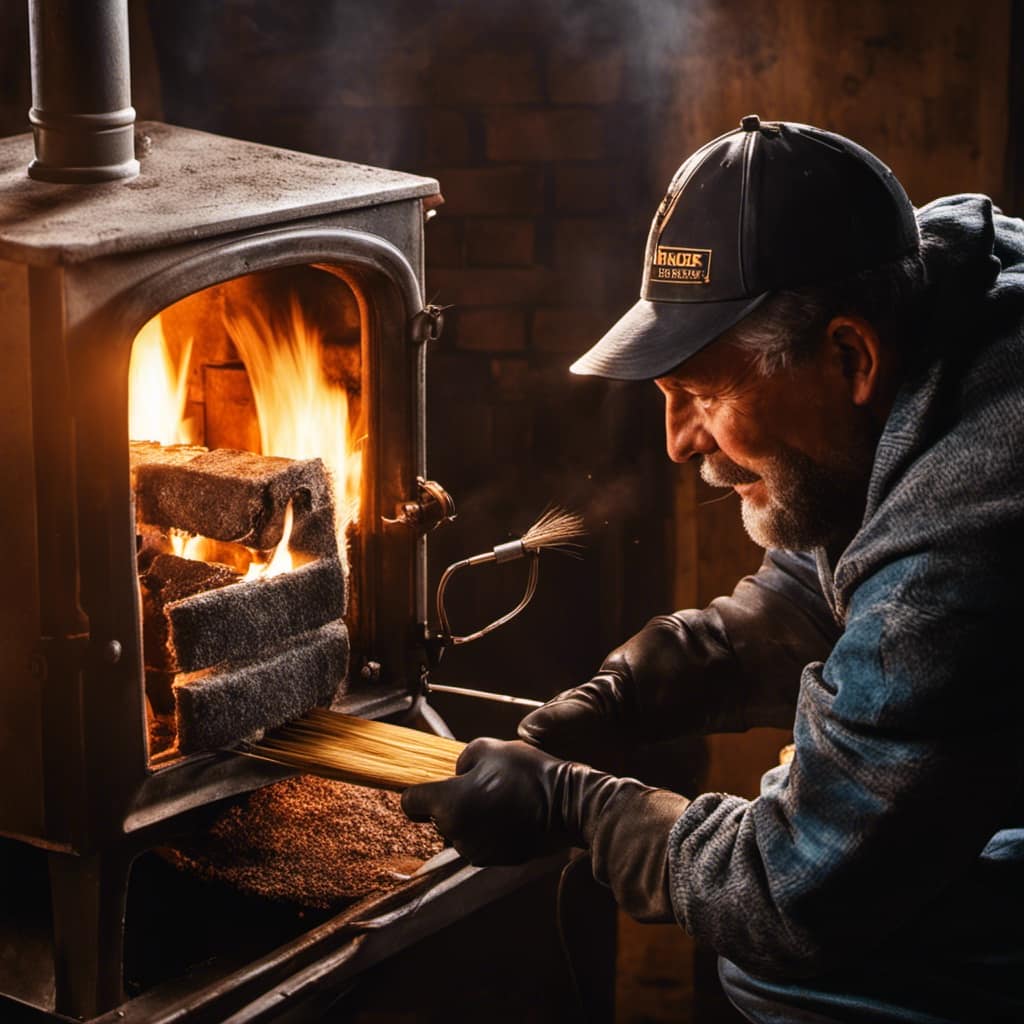
As an experienced cleaner, I know that having the right equipment is essential for a successful cleaning session.
From chimney brushes and rods to ash vacuums and scrapers, ensuring that you’ve everything you need will make the process smoother and more efficient.
Essential Cleaning Equipment
To effectively clean creosote from a wood stove, I need a wire brush and a shop vacuum. These are the essential cleaning supplies that I rely on to remove stubborn stains and buildup from the stove’s interior. The wire brush is perfect for scrubbing away the hardened creosote, while the shop vacuum efficiently sucks up the loosened debris. Additionally, I find it helpful to have a few other tools on hand, such as a scraper and a dustpan, to aid in the cleaning process. These tools allow me to scrape off any remaining residue and collect the debris for easy disposal. With the right equipment and a little elbow grease, I can ensure that my wood stove remains clean and efficient.
| Essential Cleaning Supplies | Removing Stubborn Stains |
|---|---|
| Wire brush | Scrubs away creosote |
| Shop vacuum | Sucks up debris |
| Scraper | Removes residue |
| Dustpan | Collects debris |
Proper Protective Gear
Wearing the proper protective gear, like gloves and goggles, is essential when working with a wood stove. As someone who’s cleaned many wood stoves, I know the importance of safety precautions. Here are some key items to consider when it comes to proper protective gear:

-
Gloves: Thick, heat-resistant gloves will protect your hands from burns and splinters while handling hot stove components.
-
Goggles: Safety goggles shield your eyes from flying debris, sparks, and dust, ensuring clear vision and preventing eye injuries.
-
Respirator or Mask: A respirator or mask will filter out harmful particles and fumes, providing clean air to breathe and protecting your respiratory system.
By wearing these items, you can minimize the risk of accidents and injuries while cleaning your wood stove.
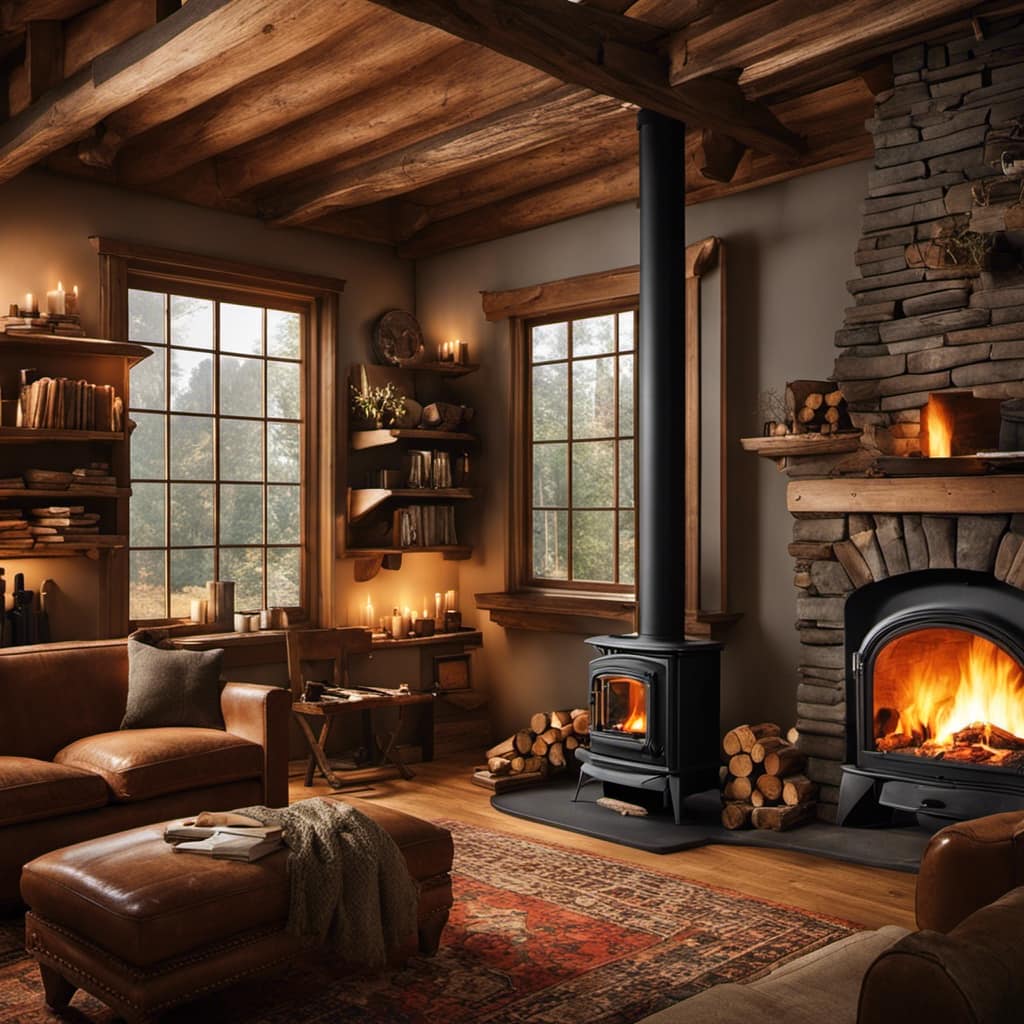
Safety should always be a top priority when working with any heating appliance.
Recommended Cleaning Products
As someone who’s maintained many wood stoves, I highly recommend using a chimney cleaning log to keep your flue clear of buildup. These logs are a safe and effective way to remove creosote and other residues from the chimney walls. They work by releasing special chemicals that break down the creosote, making it easier to remove.
It’s important to use eco-friendly cleaning products when caring for your wood stove and chimney. Look for products that are biodegradable and non-toxic, as they’re better for the environment and your health.
By choosing safe cleaning methods and eco-friendly products, you can ensure a clean and efficient wood stove that will provide warmth and comfort throughout the winter.
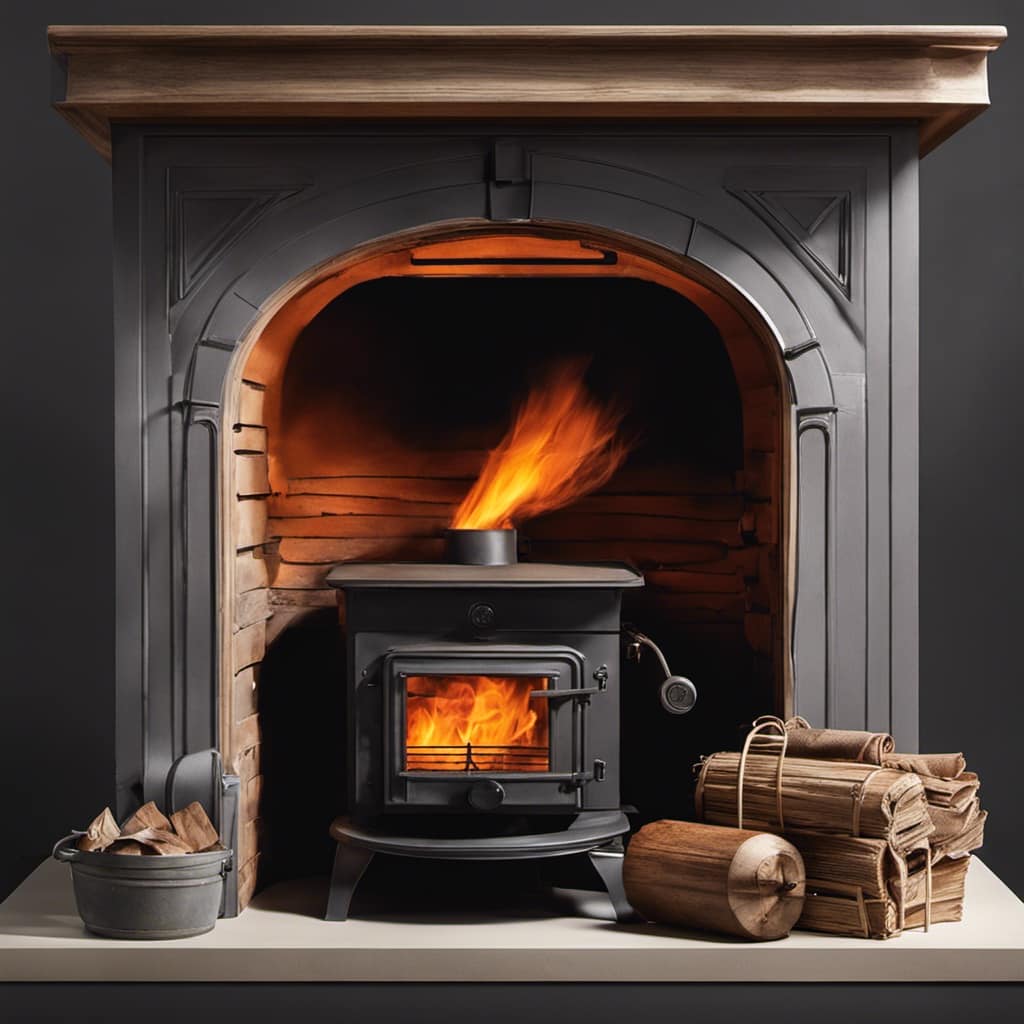
Now, let’s move on to preparing your wood stove for cleaning.
Preparing Your Wood Stove for Cleaning
I’m getting ready to clean my wood stove, so the first step is to make sure it’s properly prepared. Wood stove maintenance is crucial for its efficient and safe operation, and regular cleaning plays a vital role in this process. Here are a few important steps to prepare your wood stove for cleaning:
-
Gather the necessary tools: Before starting the cleaning process, gather the necessary tools such as a wire brush, ash vacuum, scraper, and a dustpan. Having these tools handy will make the cleaning process much smoother and efficient.
-
Ensure proper ventilation: Open the windows or doors in the room where the wood stove is located to ensure proper ventilation. This will help in minimizing the amount of dust and soot particles that may circulate in the air during the cleaning process.
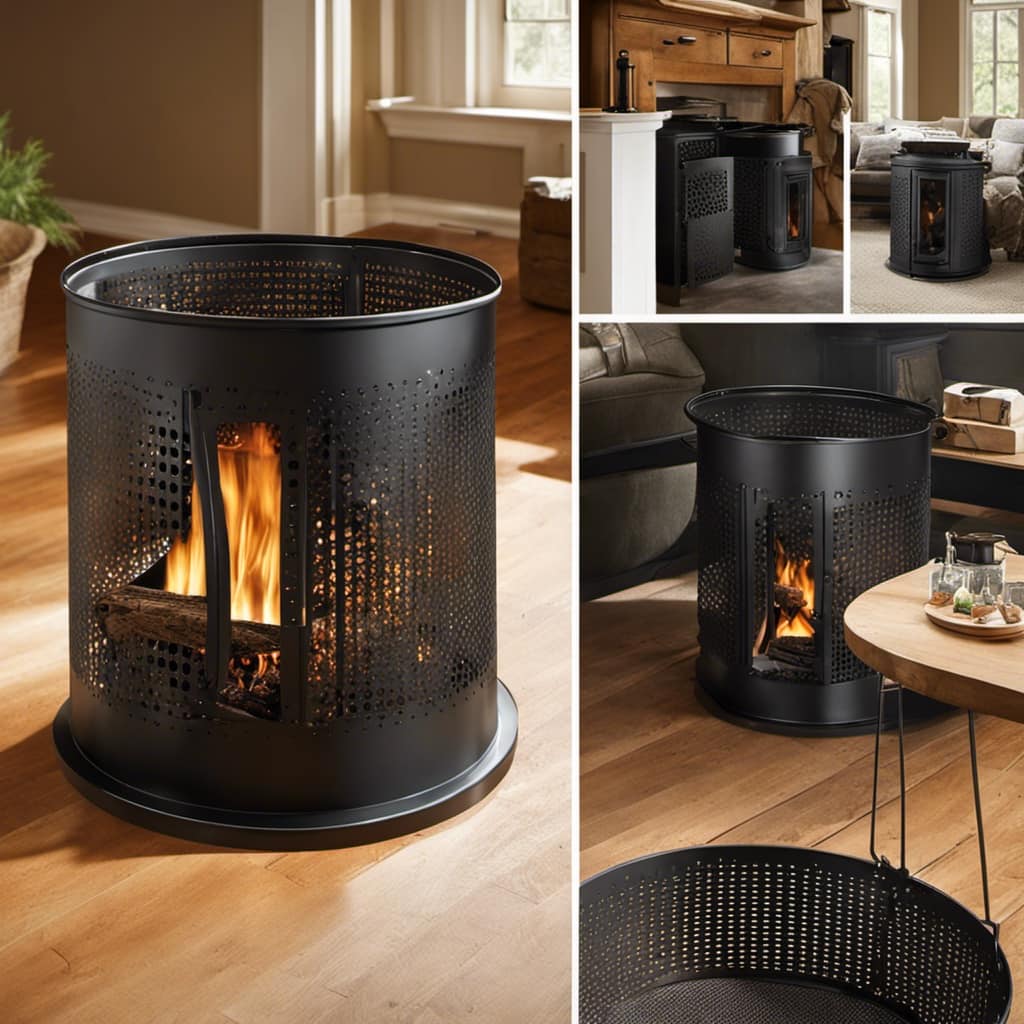
-
Protect the surrounding area: Cover the surrounding area around the wood stove with a drop cloth or old newspapers to prevent any mess. Cleaning a wood stove can be a messy task, and by taking this precaution, you can save yourself from the hassle of cleaning up afterwards.
Removing Surface Creosote
Now that we’ve prepared our wood stove for cleaning, it’s time to tackle the task of removing surface creosote.
Surface creosote refers to the layer of creosote that has built up on the interior surfaces of the stove, including the walls, baffles, and grates. It’s important to remove this creosote regularly to ensure the efficient and safe operation of your wood stove.
There are various creosote cleaning techniques that can be used for removing surface creosote. One effective method is to use a stiff-bristle brush or a creosote removal tool to scrape off the creosote from the surfaces. Start by removing the baffles and grates, if possible, to access all areas of the stove. Then, carefully scrub the interior surfaces with the brush or tool, making sure to reach into all the nooks and crannies where creosote may have accumulated.

After removing the surface creosote, it’s important to dispose of it properly. Creosote is highly flammable, so it should never be left inside the house or thrown into the regular trash. Instead, seal it in a bag and dispose of it in accordance with local regulations for hazardous materials.
With the surface creosote removed, we can now move on to cleaning the stove pipes and chimney, which is the next step in maintaining a clean and safe wood stove.
Cleaning the Stove Pipes and Chimney
Cleaning the stove pipes and chimney is an essential task to ensure the safe and efficient operation of your wood stove.
As an experienced chimney sweep, I know that proper maintenance involves removing any creosote buildup that can lead to chimney fires.
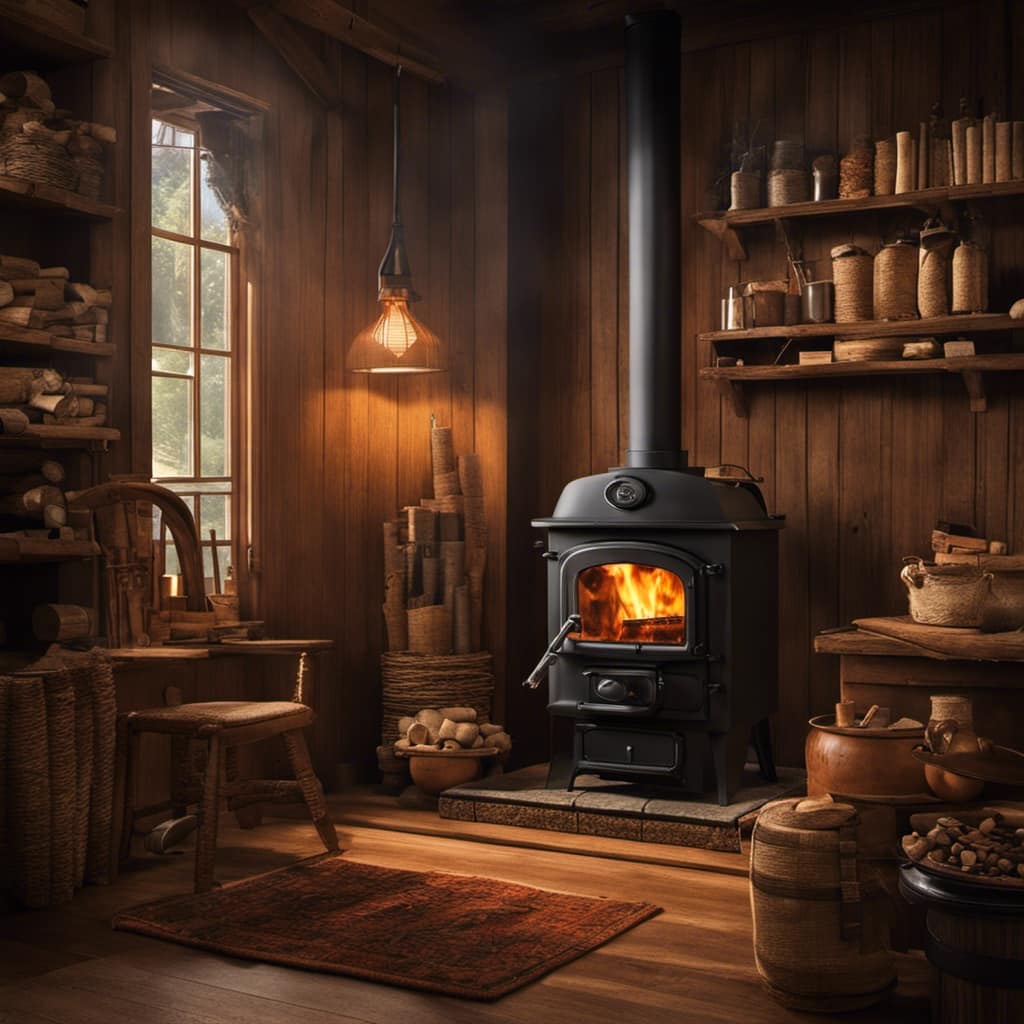
Regularly cleaning the stove pipes and chimney also improves the draft and prevents smoke from entering your home.
Proper Chimney Maintenance
To maintain a proper chimney, it’s important to regularly remove creosote from the wood stove. Creosote is a highly flammable substance that can accumulate in the chimney over time, increasing the risk of a chimney fire. By scheduling regular chimney inspections and utilizing chimney sweep services, you can ensure that your chimney stays clean and safe.
Here are three key benefits of proper chimney maintenance:
-
Increased Safety: Regular chimney inspections can identify any potential issues, such as blockages or cracks, that could pose a safety hazard.
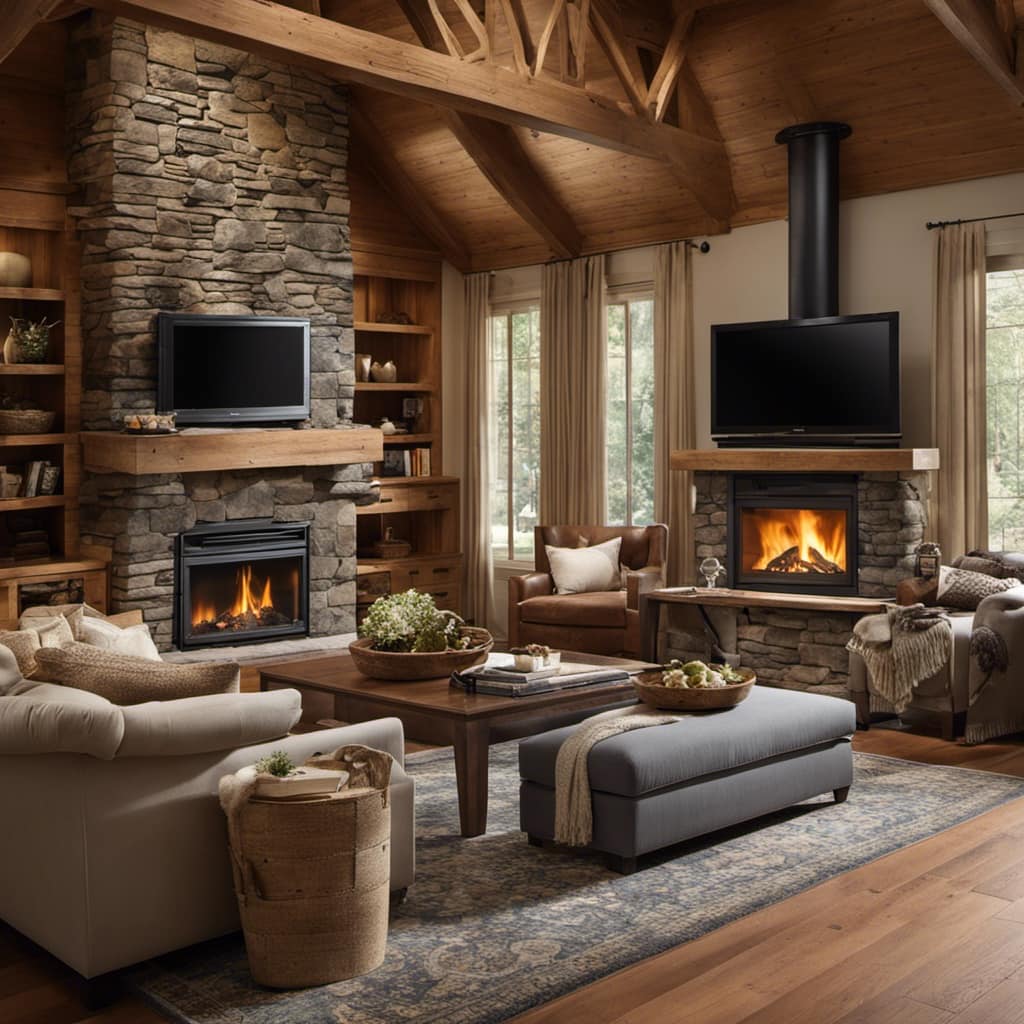
-
Improved Efficiency: A clean chimney allows for better airflow, which improves the efficiency of your wood stove and reduces the amount of smoke and pollutants released into the environment.
-
Longevity of the Chimney: Proper maintenance helps prolong the lifespan of your chimney, saving you money in the long run by preventing costly repairs or replacements.
With regular chimney inspections and chimney sweep services, you can enjoy a safe and efficient wood stove experience.
Removing Creosote Buildup
I need to schedule a chimney inspection and sweep to ensure the safety and efficiency of my fireplace. It’s important to take proactive steps in preventing creosote buildup, as it can pose serious risks such as chimney fires. Regular maintenance is key in keeping your chimney free from this hazardous substance. There are various creosote removal methods available, each with its own advantages and disadvantages. Here is a table that provides an overview of some common creosote removal methods:
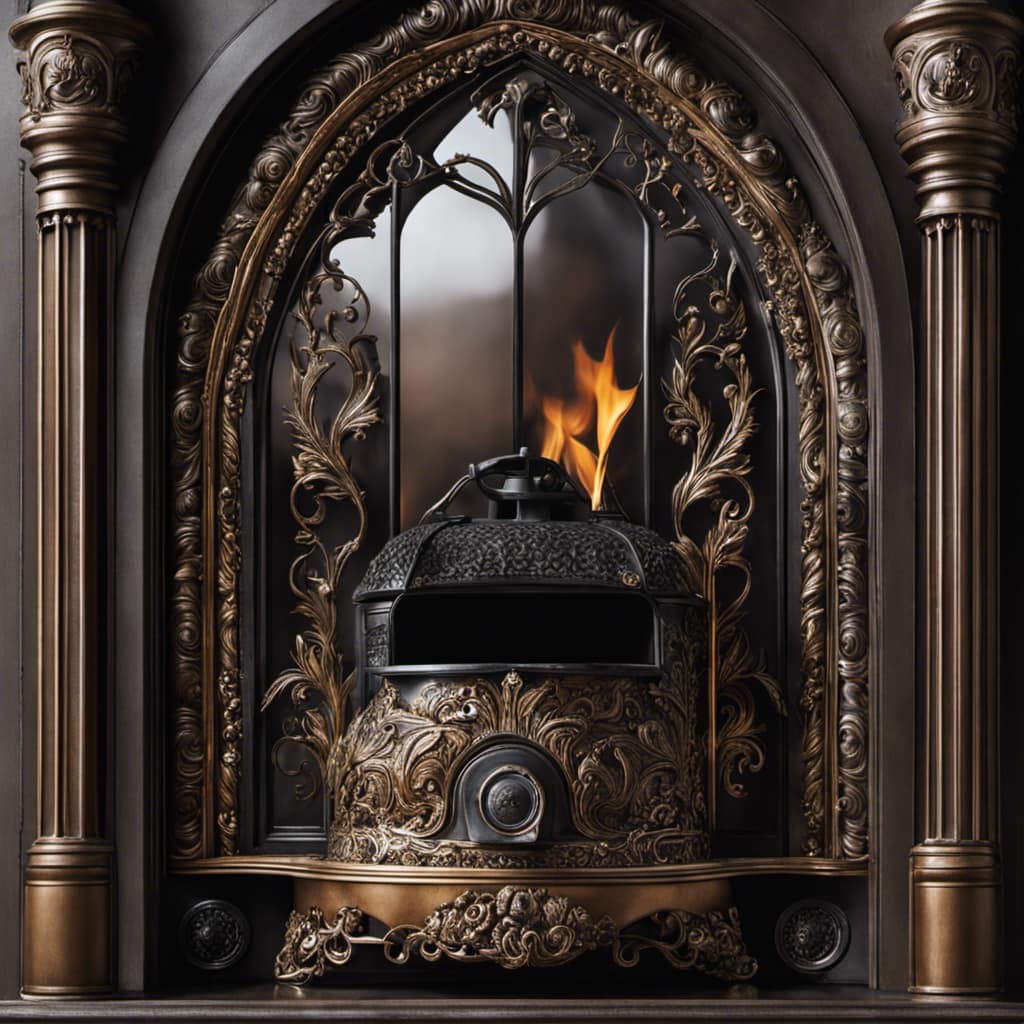
| Method | Description | Effectiveness |
|---|---|---|
| Mechanical Removal | Using brushes or scrapers to physically remove creosote | Highly effective |
| Chemical Treatment | Applying chemicals to break down creosote for easier removal | Moderately effective |
| Heat Treatment | Using high heat to burn off creosote | Highly effective, but risky |
Cleaning Stove Pipe
Having a clear and well-maintained stove pipe is crucial for the proper functioning of my fireplace. Regularly cleaning the stove pipe not only prevents creosote buildup but also ensures efficient heat transfer and reduces the risk of chimney fires. Here are some essential tips for cleaning your stove pipe:
-
Use a chimney brush: Invest in a high-quality chimney brush that matches the size and shape of your pipe. Start from the top and work your way down, scrubbing vigorously to remove any soot or creosote deposits.
-
Inspect for damage: While cleaning, carefully inspect the stove pipe for any signs of damage, such as cracks or corrosion. Addressing these issues promptly will help maintain the integrity of the pipe and prevent future problems.
-
Clear obstructions: During the cleaning process, check for any obstructions like bird nests, leaves, or debris. Remove them to ensure proper airflow and prevent dangerous blockages.
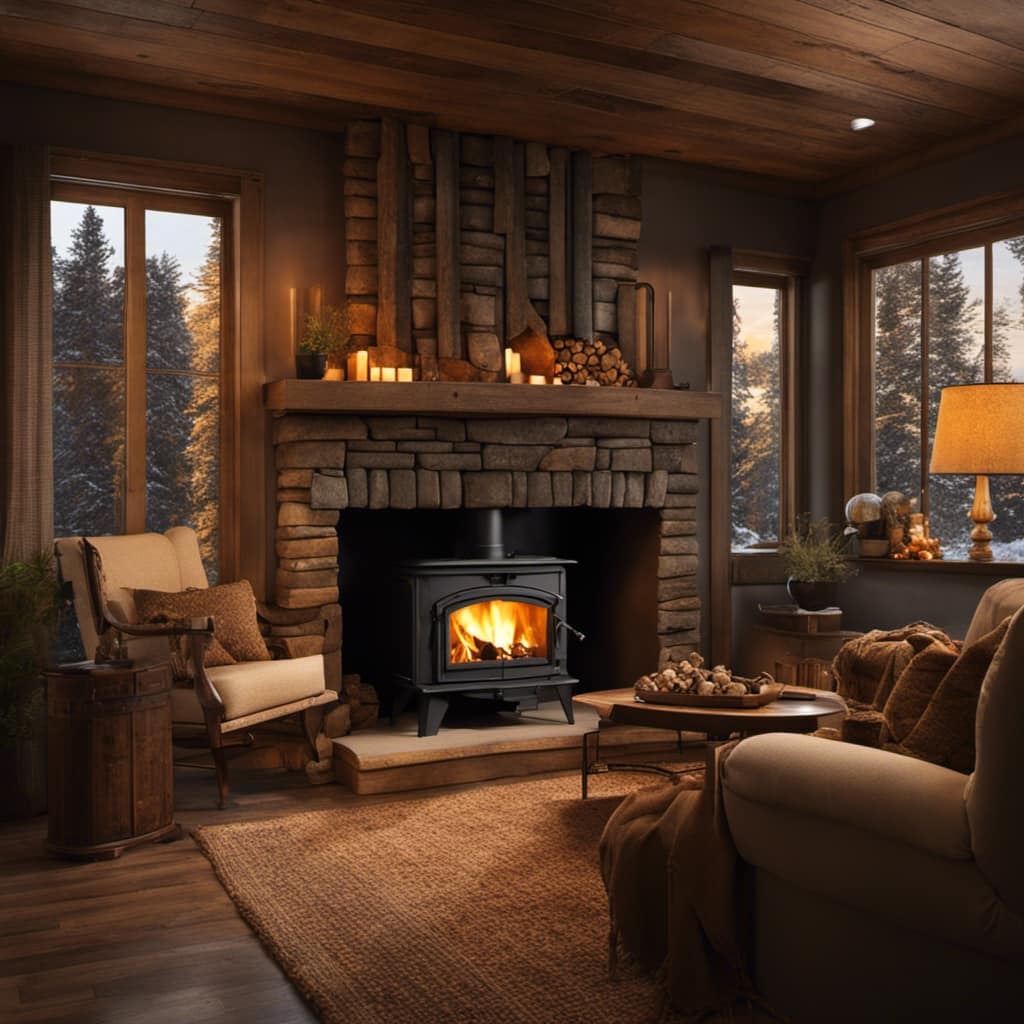
Dealing With Stubborn Creosote Deposits
I’ve found that using a wire brush can effectively remove stubborn creosote deposits from my wood stove. Dealing with stubborn creosote deposits can be a challenging task, but with the right techniques, it can be done effectively. Creosote is a highly flammable substance that forms when wood is burned incompletely. Over time, it can accumulate on the walls of the stove and stove pipe, posing a serious fire hazard.
To tackle this issue, it’s important to have effective creosote removal techniques in place.
One of the most effective techniques I’ve found is using a wire brush. This tool is specifically designed to scrape away the hardened creosote deposits from the stove walls and pipe. It’s important to use a brush with stiff bristles to ensure thorough cleaning. Start by removing any loose debris from the stove and pipe, then scrub the affected areas using the wire brush. Be sure to wear protective gloves and goggles to prevent any injuries. After scrubbing, use a vacuum cleaner or a brush to remove the loosened creosote from the stove. Repeat this process as necessary until all the deposits are removed.
In addition to using a wire brush, it’s also important to have regular maintenance and cleaning of the wood stove. This includes removing ashes and cleaning the stove pipe at least once a year.

Preventing Future Creosote Buildup
Now that we’ve covered how to deal with stubborn creosote deposits, let’s talk about preventing future buildup. As someone who’s been using wood stoves for years, I understand the importance of keeping creosote at bay to avoid potential fires.
Here are some effective techniques to prevent future creosote buildup:
-
Regular chimney inspections: Schedule annual inspections to identify any potential creosote buildup or other issues. A professional chimney sweep can thoroughly clean and inspect your chimney, ensuring it’s in good working condition.
-
Proper wood selection and seasoning: Burning dry, well-seasoned hardwoods significantly reduces creosote formation. Moisture in unseasoned wood promotes creosote buildup, so it’s crucial to properly season your firewood before using it.
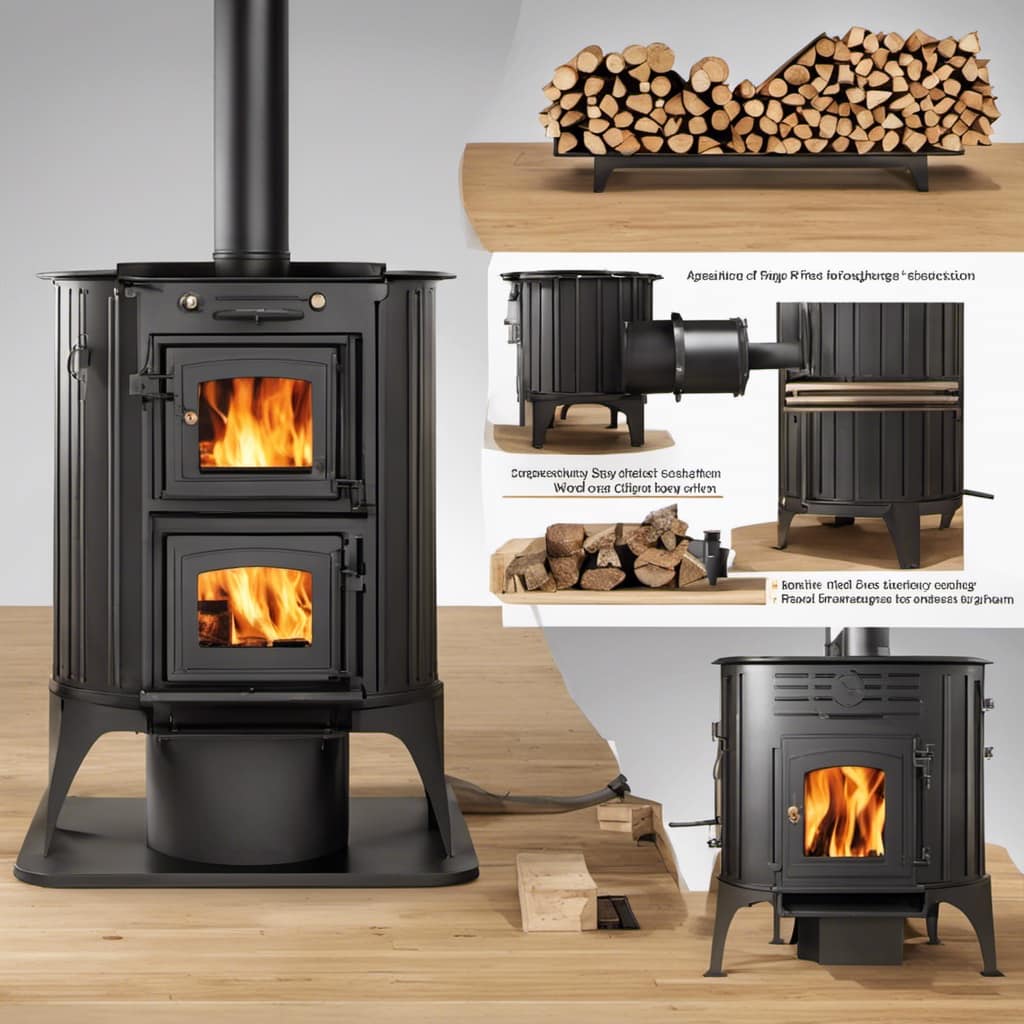
-
Efficient burning practices: To minimize creosote formation, maintain a hot and efficient fire. Avoid smoldering fires and instead build a well-ventilated fire that burns at a high temperature. This helps to burn off any potential creosote buildup.
Tips and Tricks for Maintaining a Clean Wood Stove
As an experienced user of wood stoves, I’ve found that regular maintenance is crucial for keeping my heating source efficient and safe. Understanding the dangers of creosote buildup and avoiding common wood stove cleaning mistakes are key to maintaining a clean wood stove.
Creosote is a byproduct of burning wood and can accumulate in the chimney and stovepipe over time. If not properly cleaned, it can lead to chimney fires, poor draft, and reduced efficiency. That’s why it’s important to regularly inspect and clean your wood stove.
One common mistake to avoid is neglecting to clean the stovepipe. Creosote can build up in the stovepipe, restricting airflow and increasing the risk of a chimney fire. Make sure to clean the stovepipe at least once a year using a chimney brush.
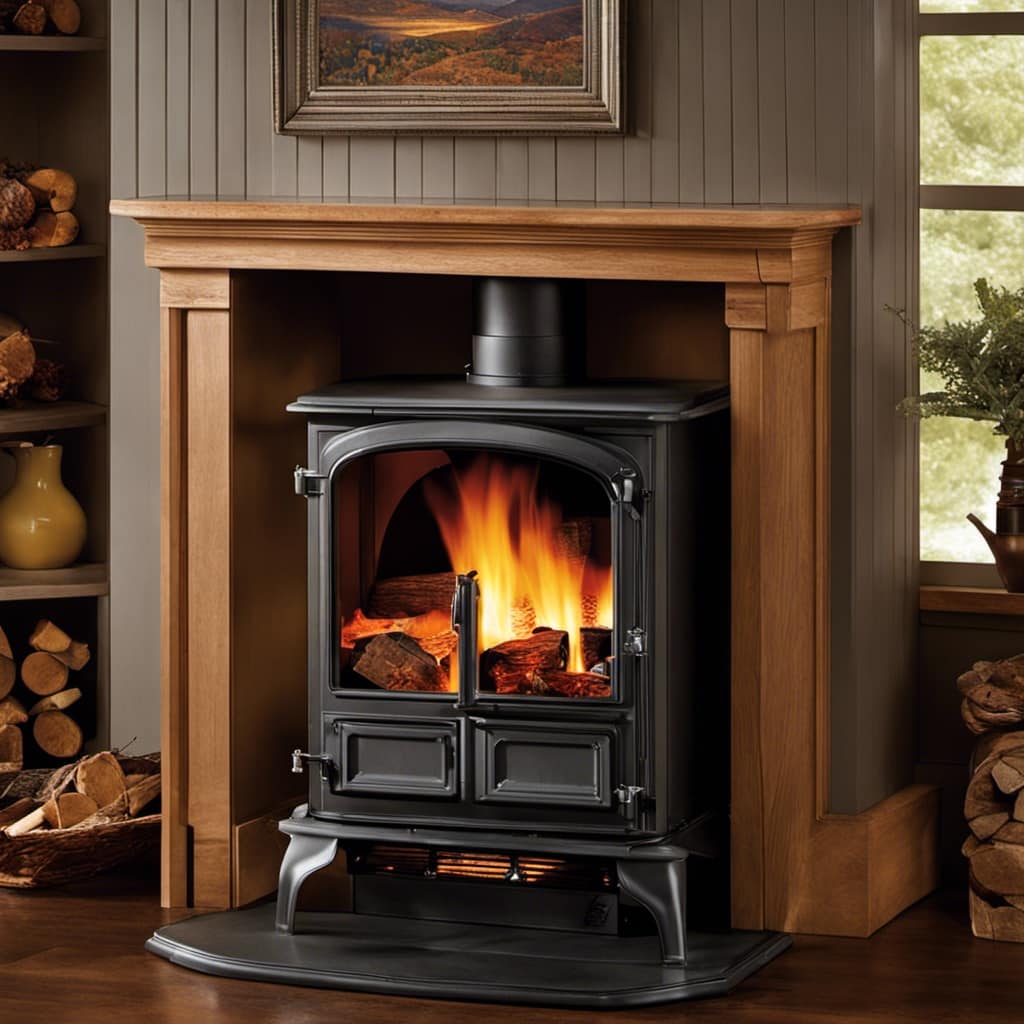
Another mistake to avoid is using improper cleaning techniques. Avoid using water or household cleaners to clean your wood stove, as they can damage the stove’s interior. Instead, use a wire brush or scraper to remove any built-up creosote. Be sure to wear protective gloves and goggles to protect yourself from any debris.
Maintaining a clean wood stove is essential for its longevity and safety. By understanding the dangers of creosote buildup and avoiding common cleaning mistakes, you can ensure that your wood stove operates efficiently and safely for years to come.
Frequently Asked Questions
How Often Should I Clean My Wood Stove to Prevent Creosote Buildup?
I clean my wood stove regularly to prevent creosote buildup. It’s important to maintain a clean stove to ensure efficient and safe operation.
Creosote can accumulate quickly, especially if you use your stove frequently. Cleaning frequency depends on usage, but a general rule of thumb is to clean it at least once every season. Regular cleaning helps remove creosote and reduces the risk of chimney fires.

Don’t forget to inspect and clean the chimney as well for optimal performance.
Can I Use Household Cleaning Products to Remove Creosote From My Wood Stove?
Can I just say, using household cleaning products to remove creosote from your wood stove is like trying to put out a forest fire with a water pistol. It’s just not gonna cut it.
Trust me, I’ve been there. But fear not, my friend, for there are effective alternatives. So let’s dive into the wonderful world of creosote removal and explore some tried and true methods that will leave your wood stove sparkling clean.
Is It Safe to Clean the Stove Pipes and Chimney by Myself, or Should I Hire a Professional?
When it comes to cleaning the stove pipes and chimney, there are safety considerations to take into account. While some DIY enthusiasts may feel confident in tackling the job themselves, it’s important to prioritize safety.
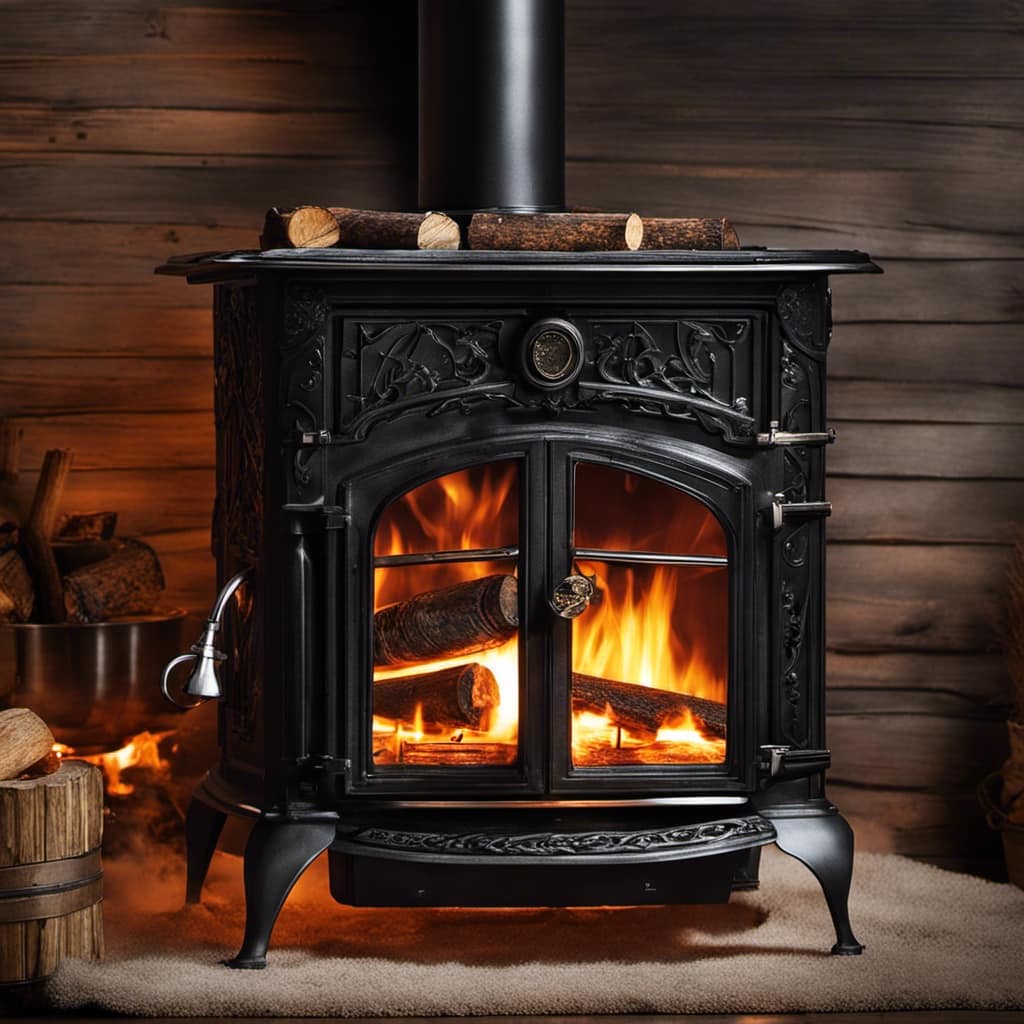
Hiring a professional chimney cleaner ensures that the task is done correctly and minimizes the risk of accidents or damage to your home. Remember, the safety of your home and family should always be the top priority.
What Are Some Signs That Indicate I Have Stubborn Creosote Deposits in My Wood Stove?
Signs of stubborn creosote deposits in my wood stove can include a strong, smoky odor, a buildup of thick, black, tar-like substance on the stove walls, and difficulty in getting a good fire going.
Removing these deposits requires thorough cleaning and regular maintenance. I’ve found that using a stiff brush, chimney sweep rods, and a creosote removal product can effectively break down and remove the creosote.
Regular inspections and cleanings are essential to ensure the safety and efficiency of my wood stove.
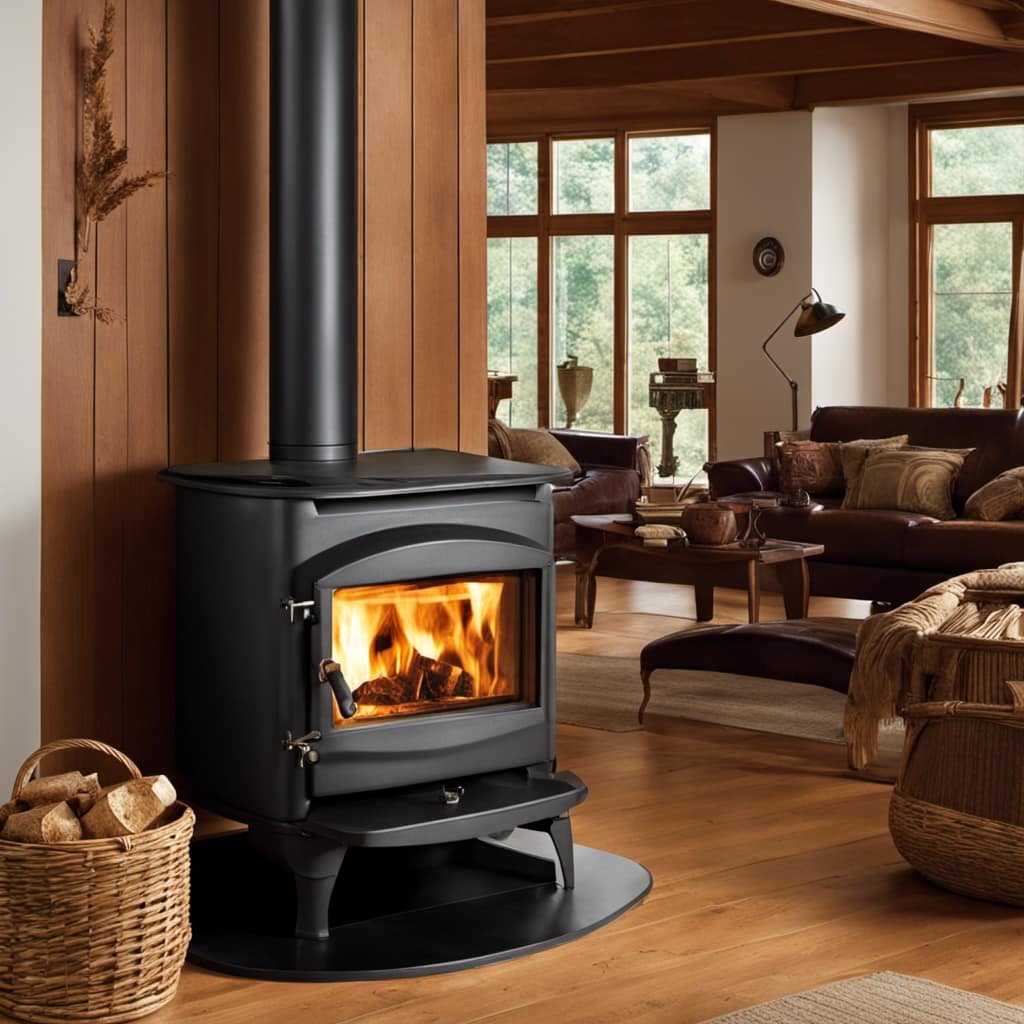
Are There Any Alternative Methods or Products That Can Help Prevent Creosote Buildup in the Future?
Well, when it comes to preventing creosote buildup in the future, there are indeed some alternative methods and natural cleaners that can help.
It’s important to stay proactive in maintaining your wood stove to avoid the hassle of cleaning stubborn creosote deposits later on.
Conclusion
In conclusion, keeping your wood stove clean and free from creosote buildup is essential for safety and efficiency.
By regularly removing surface creosote, cleaning the stove pipes and chimney, and taking preventative measures, you can ensure that your wood stove functions optimally and reduces the risk of chimney fires.
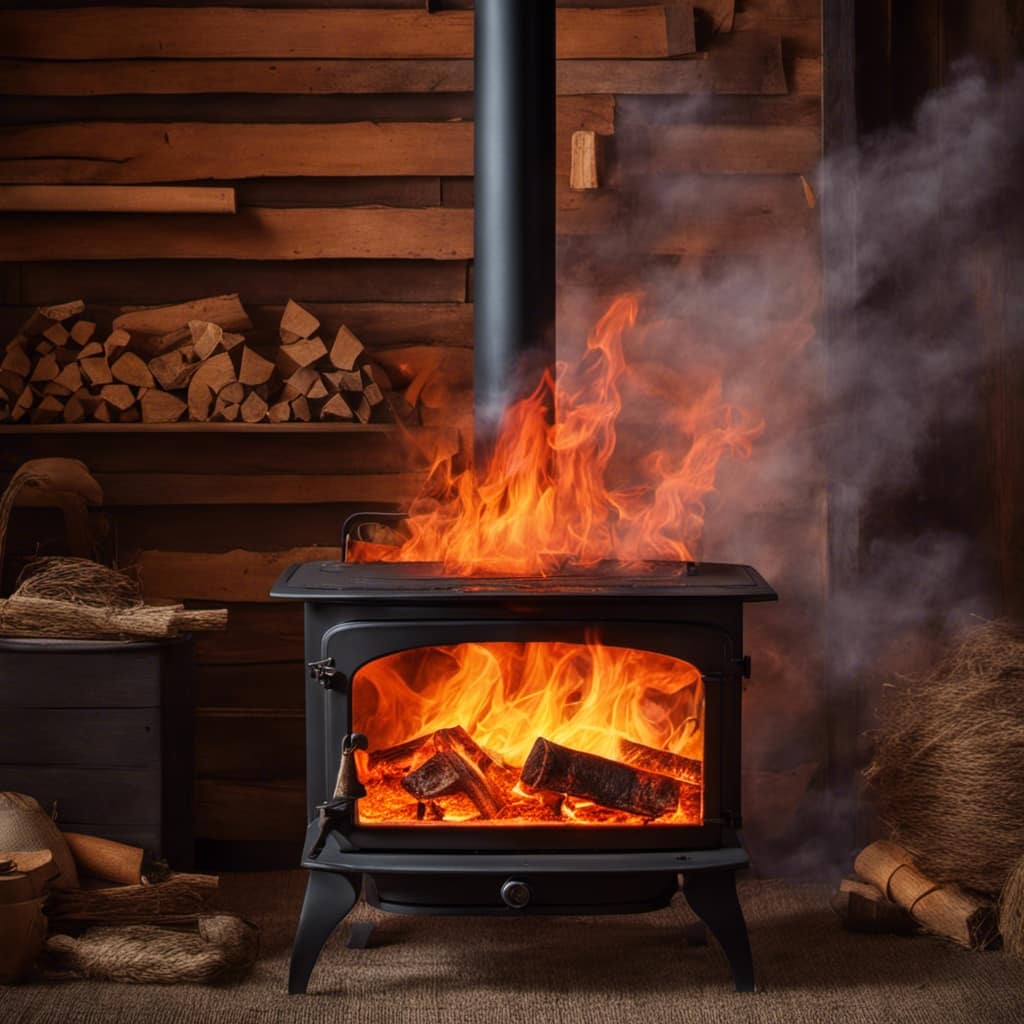
So, take the necessary steps to maintain a clean wood stove and enjoy the warmth and comfort it brings to your home.
Remember, a clean wood stove is a happy wood stove!
Growing up surrounded by the vast beauty of nature, Sierra was always drawn to the call of the wild. While others sought the comfort of the familiar, she ventured out, embracing the unpredictable and finding stories in the heartbeat of nature.
At the epicenter of every remarkable venture lies a dynamic team—a fusion of diverse talents, visions, and passions. The essence of Best Small Wood Stoves is crafted and refined by such a trio: Sierra, Logan, and Terra. Their collective expertise has transformed the platform into a leading authority on small wood stoves, radiating warmth and knowledge in equal measure.











